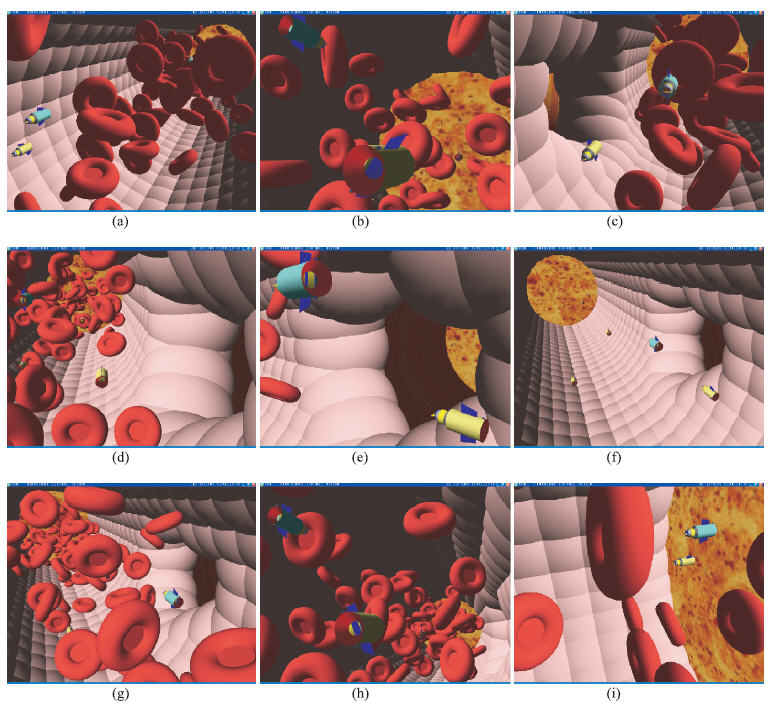Nanorobot for Brain Aneurysm

The idea of nanorobots floating throughout our arteries to fight diseases and deliver drugs is migrating from science fiction to medical fact, at least in virtual 3D simulations. Nanorobotics pioneer Adriano Cavalcanti and his colleagues report progress with their nanorobot control design (NCD) software which helps them simulate the behavior of future nanorobots. (Readers may recall the influenza virus as an example covered here). The team released a new paper that proposes a model for how a nanorobot should help with the early detection of cerebral aneurysm.
In the abstract they write: "To illustrate the proposed approach, the nanorobots must search for protein overexpression signals in order to recognize initial stages of aneurysm. An advanced nanomechatromics simulator, using a three-dimensional task-based environment, is implemented to provide an effective tool for device prototyping and medical instrumentation analysis."
Noteworthy, they point out that this development was the result of a highly collaborative effort and a synthesis of several advanced technologies: "The current study establishes proteomics, nanobioelectronics, and electromagnetics as the basis to advance medical nanorobotics."
So how does a nanorobot detect a cerebral aneurysm? First the research team, which includes the Center for Automation in Nanobiotech (CAN) along with Bijan Shirinzadeh from Monash University, and Toshio Fukuda and Seiichi Ikeda from Nagoya University, had to select an approach to developing nanorobots for common use in medicine. They ruled out "positional nanoassembly" and any organic-approaches such as bacteria-based nanorobots due to their limitations.
Instead, the team chose a nano-integrated circuit version that uses hybrid materials, photonics, and wireless communication for manufacturing and control. Then they identified and applied the following three key required pieces to advance the development and implementation of medical nanorobotics, according to the paper published by The International Journal of Robotics Research:
- Equipment prototyping: Computational nanotechnology provides a key tool for the fast and effective development of nanorobots, helping in the investigation to address major aspects on medical instrumentation and device prototyping.
- The manufacturing technology: For manufacturing purposes, the nanorobot should be integrated as a biochip device.
- Inside-body transduction: Cell morphology, microbiology, and proteomics are used as parameters for nanorobot morphology and inside-body interaction. Changes on chemical gradients and telemetric instrumentation are used for medical prognosis, with the nanorobots activation based on proteomic overexpression.
The process within each of the above components is detailed in the paper replete with technical terms, but the figure below illustrates the process neatly for you:
Nanorobots used to detect brain aneurysm: (a) the nanorobots enter the vessel and flow with the bloodstream (b) the nanorobots are moving through the vessel with the fluid (c) the aneurysm saccular bulb begins to become visible at the vessel wall (d) nanorobots move closer to the vessel deformation (e) mixed with the plasma, NOS (nitric oxide synthase) signals can be detected as the chemical gradient changes, denoting proteomic overexpression (f) the same workspace viewed without red cells (g) the nanobiosensor is activated as the nanorobots move closer to the aneurysm, emitting RF signals sent to the cell phone (h) as the nanorobots keep flowing, the chemical signals become weaker, deactivating the nanorobot transmission (i) red cells and nanorobots flow with the bloodstream until they leave the vessel.
Finally, here's a key excerpt from the conclusion and outlook. "The nanomachine platform design was based on clinical data, proteomic signals, cell morphology, and numerical analysis. For the proposed model, the nanorobots were able to recognize chemical gradient changes in the bloodstream, retrieving information about the position inside the vessel as intracranial aneurysm detection. An important and interesting aspect in the current development is the fact that this platform, presented in terms of device prototyping and system architecture integration, can also be useful for a broad range of applications in medicine."
Just as 3D simulations once helped engineers and designers push forward developmental research in the semiconductor industry, Cavalcanti and colleagues hope that it'll accelerate the progress of nanorobot development as well. They see a movement toward the use of emerging nanotechnologies for medical applications in the same way as we did in the 1980's with microdevices used in surgery and medical treatments.
